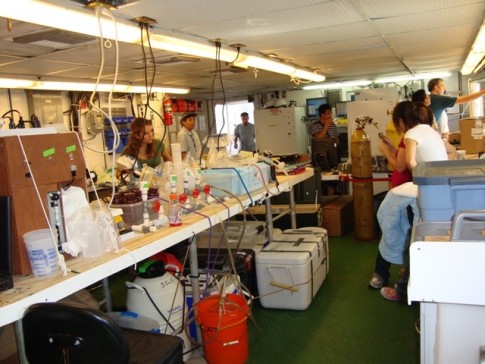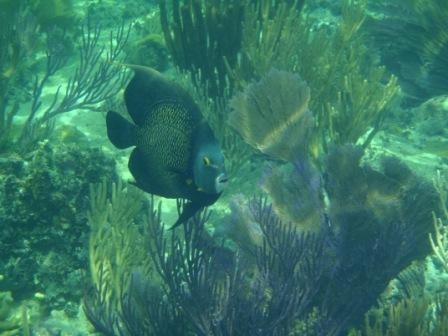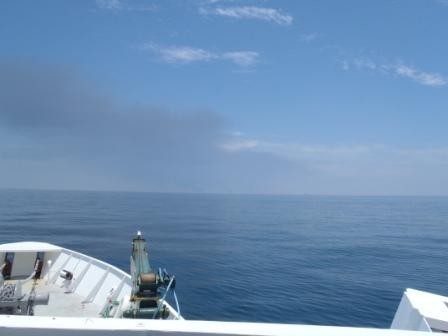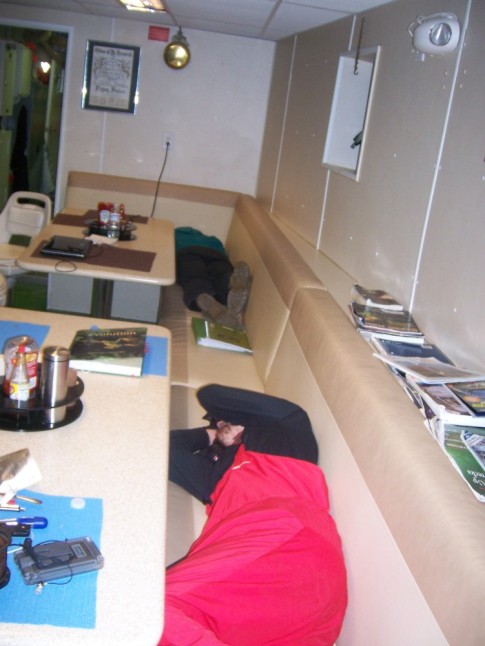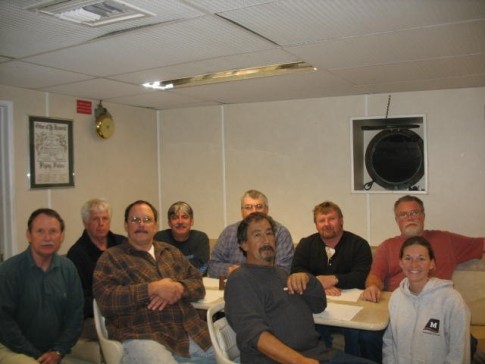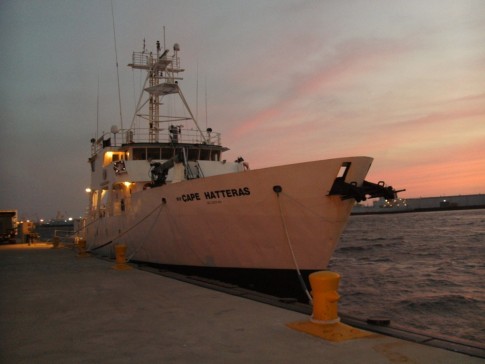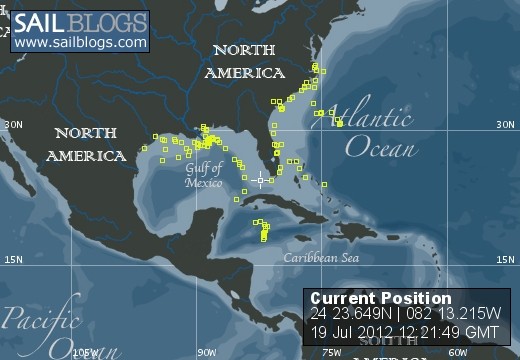
Research Vessel Cape Hatteras
The R/V CAPE HATTERAS is owned by the National Science Foundation and operated under a renewable Charter Party Agreement by the Duke/UNC Oceanographic Consortium. Her homeport is at Duke University Marine Laboratory in Beaufort, North Carolina.
11 March 2013
01 February 2013 | Beaufort, NC
14 January 2013
14 January 2013
19 July 2012 | Straits of Florida
19 July 2012
04 July 2012
15 November 2011 | East Flower Garden Banks, Gulf of Mexico
06 November 2011 | East Flower Garden Back, Gulf of Mexico
05 November 2011 | Gulf of Mexico
27 August 2011 | North Charleston, SC
26 August 2011 | North Charleston, SC
25 August 2011 | off SC coast
23 August 2011 | off the coast of NC
23 August 2011 | Off the coast of NC
06 August 2011 | Gulf of Mexico
05 August 2011 | GUlf of Mexico
30 June 2011 | Gulf of Mexico
30 June 2011 | Charleston, SC
25 May 2011 | Mission Annelid: Success
Day 6
24 May 2011 | Headed back to shore
Ken Halanych

We are on the last day of collecting during our WormNet cruise and we have been heading west by southwest back to the dock. When we get back I am sure that we will get questions like: “Why were you at sea for a week to study worms?”; “ Do the worms at the bottom of the ocean look like earthworms?”; and “Are there a lot of different types of worms?” Good questions!
This cruise we are on was funded by the National Science Foundation as part of a larger multi-national grant to study the evolution of these animals. We are not focusing on all worms but in particular a group called annelids, or segmented worms. Perhaps the most familiar members of this group are earthworms. However compared to other annelid body shapes, earthworms are fairly plain. Other annelids have tentacles, multiple eyes, sharp needle like projections called chaetae, and jaws that they can shoot out of their mouth to catch prey. Good thing that they are much smaller than us! Moreover, annelids are one of the largest phyla, or groups, of animals in terms of numbers of recognized species. Like many invertebrate animals, their diversity is seriously underestimated and they are one of the most common groups in the deep sea. This is why we wanted to go offshore and look at animals over 2000m, or 1.2 miles, deep!
Annelids are diverse! In fact they are so diverse that no-one person can be an expert on ALL annelids. In fact, just on this cruise we have different worm biologists that specialize on different groups, such as Cirratulidae, Oligochaeta, Dorvilleidae, Sipunculida, and Siboglinidae – that is quite and alphabet soup of names!! Because we also get other animals we also have other specialist for other groups, such as snails, sea stars and a small molluscan group called aplacophorans. But this is what makes the cruise so much fun, we get to spend time next to colleagues from all over the world!
As we head in to dock, we still have a lot of work to do! Not only are we finishing up sorting samples, but we need to clean and pack things so that we are ready to get off the boat. When you have been spending six days playing in sand and mud, cleaning up takes a little effort. The more important issues will be to make sure we have all the critical information properly recorded and stored for later use and to discuss what the next steps are when we are back in the lab. So today is extra busy in some ways. What is making it more challenging for some is that today we have 20 knot winds and 4-5 foot seas. That means that looking under the microscopes is very challenging because the critters slosh back and forth.
In addition to the science side of the cruise finishing up, the ship’s crew has things to do as well. Not only are they thinking about our cruise finishing, but they are already planning for the next cruise. Fortunately for us, this crew has been awesome and has been most helpful with the scientific work. One of the key components for a great cruise is good communication between the scientist and the crew. Although some times the news is not what you expect. We were just told by the Captain then when we get past the shoals at Cape Lookout we can expect up to 6 -7 foot waves. That is not that bad, but it will give use a bumpy ride on the way in.
This cruise we are on was funded by the National Science Foundation as part of a larger multi-national grant to study the evolution of these animals. We are not focusing on all worms but in particular a group called annelids, or segmented worms. Perhaps the most familiar members of this group are earthworms. However compared to other annelid body shapes, earthworms are fairly plain. Other annelids have tentacles, multiple eyes, sharp needle like projections called chaetae, and jaws that they can shoot out of their mouth to catch prey. Good thing that they are much smaller than us! Moreover, annelids are one of the largest phyla, or groups, of animals in terms of numbers of recognized species. Like many invertebrate animals, their diversity is seriously underestimated and they are one of the most common groups in the deep sea. This is why we wanted to go offshore and look at animals over 2000m, or 1.2 miles, deep!
Annelids are diverse! In fact they are so diverse that no-one person can be an expert on ALL annelids. In fact, just on this cruise we have different worm biologists that specialize on different groups, such as Cirratulidae, Oligochaeta, Dorvilleidae, Sipunculida, and Siboglinidae – that is quite and alphabet soup of names!! Because we also get other animals we also have other specialist for other groups, such as snails, sea stars and a small molluscan group called aplacophorans. But this is what makes the cruise so much fun, we get to spend time next to colleagues from all over the world!
As we head in to dock, we still have a lot of work to do! Not only are we finishing up sorting samples, but we need to clean and pack things so that we are ready to get off the boat. When you have been spending six days playing in sand and mud, cleaning up takes a little effort. The more important issues will be to make sure we have all the critical information properly recorded and stored for later use and to discuss what the next steps are when we are back in the lab. So today is extra busy in some ways. What is making it more challenging for some is that today we have 20 knot winds and 4-5 foot seas. That means that looking under the microscopes is very challenging because the critters slosh back and forth.
In addition to the science side of the cruise finishing up, the ship’s crew has things to do as well. Not only are they thinking about our cruise finishing, but they are already planning for the next cruise. Fortunately for us, this crew has been awesome and has been most helpful with the scientific work. One of the key components for a great cruise is good communication between the scientist and the crew. Although some times the news is not what you expect. We were just told by the Captain then when we get past the shoals at Cape Lookout we can expect up to 6 -7 foot waves. That is not that bad, but it will give use a bumpy ride on the way in.
Comments
| Vessel Name: | R/V Cape Hatteras |
| Hailing Port: | Beaufort, NC |
| Extra: | |
| Home Page: | www.rvcapehatteras.org |

Port: Beaufort, NC
